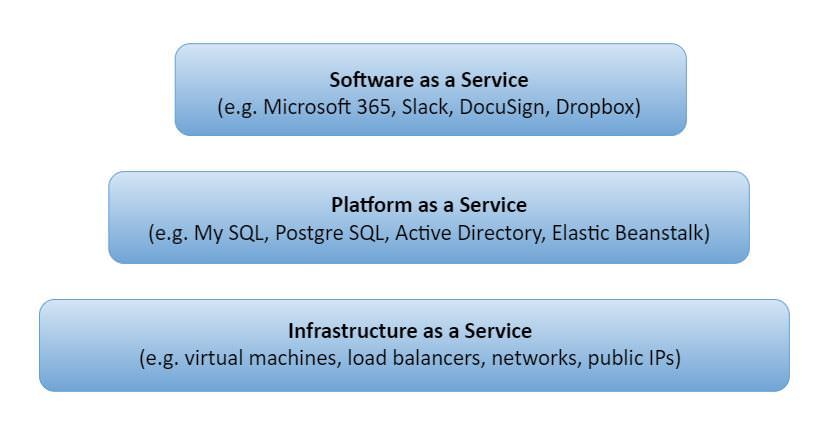This episode covers:
- definitions of cloud, IaaS, PaaS and SaaS
- the difference between cloud and data centre servers
- incentives of cloud migration
- choosing a cloud provider
We have all read or heard about needing to move to the cloud, but what is it really? It’s not some tech marvel to be feared if not understood, it’s more of a convenience service.
Many public servants are using Office 365 during COVID-19 to send email outside of the government network and conduct business through instant messaging and video calls. Office 365 runs on cloud; in fact, even this website runs on a cloud-based platform called Ghost. You’re in the cloud whether you realize it or not.
In government and large corporations, the concept of keeping data stored in large centralized ‘centres’ (data centres) has been around for a very long time, peaking in popularity in the early 2000s. The responsibility for the maintenance and upkeep of the many rows of servers that housed a data centre required dedicated staff, not only technical but administrative to oversee the procurement and valuation of aging assets.
So what does this have to do with cloud? Moving to the cloud is simply moving organization-controlled data centres to a data center controlled by a third party. Why would we do that? Mainly, convenience.
IaaS, PaaS, SaaS
At a glance they may look like someone's autocorrect didn’t do its job, but no, they actually have a pretty simple meaning. Anytime you see a letter or word followed by ‘aaS’ it stands for ‘as a service’. Infrastructure as a service (IaaS), Platform as a service (PaaS), and Software as a service (SaaS) form parts of a layered model that make up the vast majority of cloud service offerings. The services in each layer are built on the underlying layers to offer varying degrees of control and convenience.

Let’s look at it like a restaurant:
SaaS
You’re at a fine restaurant where you’re presented with a menu of items of prepared technology solutions. You point at an item on the menu: a blogging platform.
PaaS
The chef’s command center is the kitchen pass, from here orders are given to the kitchen for various components of an order; commonly heard from the pass: “Two MySQL databases, two Web Servers, and a Domain Name, on order!”. When the components are ready, the chef assembles them and serves up a solution while the cook remains ready to prepare the raw components so they can be used as part of a larger solution.
IaaS
Web server on order? They run to the freezer to get an empty virtual machine and data disks, scrounge through the pantry for an available public Internet Protocol (IP) and Operating System (OS), back to a station to assemble and season with an NGINX configuration. Voila: a web server!
Okay, so ordering from a restaurant is definitely more convenient than cooking at home where prep, cooking, and cleanup can be a hassle. But why would I want Infrastructure as a service which is like prep, cooking, and cleanup but in someone else's kitchen? Let’s explore scalability and cost.
Scale and cost
If one were to compare the cost of a physical server in a data centre to its equivalent in the cloud, it would be difficult to understand why anyone would want to migrate. Many at this point toss the cloud brochure in the recycling bin with the belief that the value proposition of cloud is overrated. The problem is that the aforementioned business decision has been made under a false pretense.
The current size of equipment you have in your data centre is not the size you will need in the cloud; doing a 1:1 cost comparison yields massively inflated cloud costs.
When moving to a new home, you don’t keep your furniture layout exactly the same; you use the different aspects of your new home, the windows, walls, and other features, to redesign your living space. Things look different depending on where they are, so why wouldn’t you rearrange your solution architecture when moving to the cloud?
Understanding how the cost differential is derived requires a quick understanding of how data centre servers and cloud servers are sized:
- data centre servers need to be sized to handle ‘peak’ demands because it is operationally impossible to add additional computational resources to meet the fluctuating daily demands
- cloud computing servers are sized to the minimal requirements that a solution will need and then scaled to higher-priced tiers as load fluctuates
Cloud providers prefer to have organizations scale as this liberates that compute power for other clients and it has the added benefit of saving the organization money. Scaling can be automated to increase and decrease based on various computation metrics on almost all Infrastructure as a service (IaaS), Platform as a service (PaaS) and Software as a service offerings (SaaS). Now, you might be wondering: how much?
Truth be told, it’s incredibly complex to cost out cloud projects.
Now, isn’t it tempting to take that cloud brochure back out of the recycling bin?
Cloud providers: how to choose?
Selecting a cloud provider isn’t as straightforward as you would hope. It’s not possible to recommend X over Y simply because it all depends on how you want to use the cloud. Enterprises have different requirements over small/medium-sized businesses and startups, like different IT solutions sometimes just fit better in different cloud environments.
Now that you know a little more about cloud it’s time to explore. Most cloud providers offer free trials or credits and even no-cost online training. Take the time to become familiar with each provider and then base a decision on what works best for you.
Additional Resources

- GC | Cloud services
- Amazon Web Services (AWS) | Introduction to AWS Elastic Beanstalk (Introduction au AWS Elastic Beanstalk, available in English only)
- LinkedIn | Cloud vs. On-Premises - Hard Dollar Costs Revisited (Cloud vs. sur place - Les coûts en dollars forts revus, available in English only)
- Gartner | Is Public Cloud Cheaper Than Running Your Own Data Center? (Le cloud public est-il moins cher que votre propre centre de données?, available in English only)
- BMC Blogs | SaaS vs PaaS vs IaaS: What’s The Difference and How To Choose (SaaS vs PaaS vs IaaS : Quelle est la différence et comment choisir?, available in English only)
- IBM | IaaS PaaS SaaS - Cloud Service Models (IaaS PaaS SaaS - Modèles de service cloud, available in French only)
- Gouvernement du Québec | Guide to cloud computing (Guide de l’infonuagique, available in French only)
- Comptables Professionnels Agréés Canada | Cloud computing (Infonuagique, available in French only)

